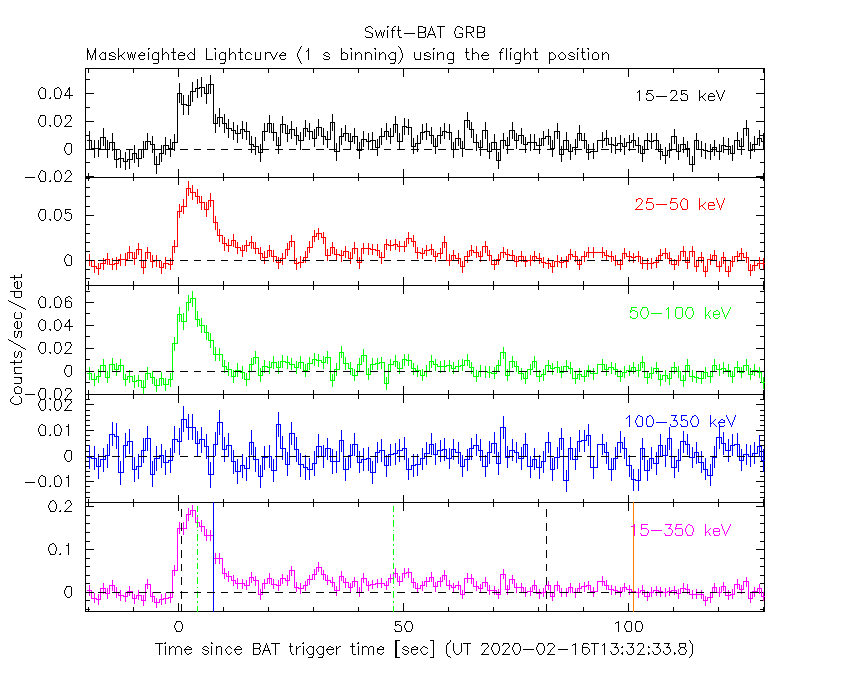
P. D'Avanzo (INAF-OAB) and N.P.M. Kuin (UCL-MSSL) for the Swift team
At 13:32:33 UT, the Swift Burst Alert Telescope (BAT) triggered and located GRB 200216B (trigger=956824) (D'Avanzo et al. GCN Circ. 27102). Swift slewed immediately to the burst. At the time of the trigger, the initial BAT position was 167° from the Sun (11.3 hours West) and 90° from the 43%-illuminated Moon. Table 1 contains the best reported positions from Swift, and the latest XRT position can be viewed at http://www.swift.ac.uk/xrt_positions.
Levan et al. (GCN Circ. 27114) reported the position from VLT for the optical afterglow of this GRB. Table 2 is a summary of GCN Circulars about this GRB from observatories other than Swift.
Standard analysis products for this burst are available at https://gcn.gsfc.nasa.gov/swift_gnd_ana.html.
As reported by Krimm et al. (GCN Circ. 27117),
the BAT ground-calculated position is RA, Dec = 160.452, 19.468 deg which is RA(J2000) = 1
The mask-weighted light curve (Figure 1) shows a single bright pulse followed by some extended emission.
The main pulse has a FRED shape, starting at T-2 s, peaking around T+2 s and decaying by T+18 s.
Lower-level extended emission with some weak pulses lasts until around T+100 s.
The time-averaged spectrum from -0.72 to +100.33 s is best fit by a power law with an exponential cutoff.
This fit gives a photon index 0.81 ± 0.52, and
The results of the batgrbproduct analysis are available at https://gcn.gsfc.nasa.gov/notices_s/956824/BA/.
Analysis of the initial XRT data was reported by D'Avanzo and Evans (GCN Circ. 27120).
We have analysed 1.6 ks of XRT data for GRB 200216B, from 105 s to 1.7 ks after the BAT trigger. The data comprise 90 s in Windowed Timing (WT) mode (the first 8 s were taken while Swift was slewing) with the remainder in Photon Counting (PC) mode. The enhanced XRT position for this burst was given by Goad et al. (GCN Circ. 27106).
The light curve (Figure 2) can be modelled with a power-law decay with a decay index of α=1.91 (+0.07, -0.06).
A spectrum formed from the WT mode data can be fitted with an absorbed power-law with a photon spectral index of 1.18 (+0.20, -0.19). The best-fitting absorption column is 7.3 (+2.3, -1.9) x 1
A summary of the PC-mode spectrum is thus:
Total column: 9.2 (+2.9, -2.5) x 1
Galactic foreground: 2.0 x 1
Excess significance: 6.0 σ
Photon index: 1.63 (+0.27, -0.26)
The results of the XRT team automatic analysis are available at http://www.swift.ac.uk/xrt_products/00956824.
The Swift/UVOT began settled observations of the field of GRB 200216B 124 s after the BAT trigger
(Kuin and D'Avanzo GCN Circ. 27108).
No optical afterglow consistent with the XRT position (Goad et al. GCN Circ. 27106) is detected in the initial UVOT exposures.
Table 3 gives preliminary
magnitudes using the UVOT photometric system
(Breeveld et al. 2011, AIP Conf. Proc., 1358, 373).
No correction has been made for the expected extinction in the Milky Way
corresponding to a reddening of

Figure 1. The BAT
mask-weighted light curve in the four individual and total
energy bands. The units are counts

Figure 2. The XRT light curve.
Any data from a crosshatched region are not included in the fit.
| RA (J2000) | Dec (J2000) | Error | Note | Reference |
|---|---|---|---|---|
| 1 |
+19°28'30.6" | 1.7" | XRT-final | UKSSDC |
| 1 |
+19°28'30.6" | 1.7" | XRT-enhanced | Goad et al. GCN Circ. 27106 |
| 1 |
+19°28'05.5" | 1.0' | BAT-refined | Krimm et al. GCN Circ. 27117 |
| Band | Authors | GCN Circ. | Subject | Observatory | Notes |
|---|---|---|---|---|---|
| Optical | Mao et al. | 27103 | GMG upper limit | Gao-Mei-Gu | upper limits |
| Optical | Xu et al. | 27104 | Nanshan/NEXT early optical upper limit and possible host galaxy |
Xinjiang Astro. Obs. | upper limits |
| Optical | de Ugarte Postigo et al. | 27110 | z-band limit from NOT | NOT | upper limits |
| Optical | Levan et al. | 27114 | possible IR counterpart from VLT | VLT | possible detection |
| Optical | Pozanenko et al. | 27122 | Mondy and AbAO optical upper limits | Abastumani Astro. Obs. | upper limits |
| Optical | Belkin et al. | 27128 | second epoch optical upper limit at Mondy observatory |
Mondy | upper limits |
| Gamma-ray | Fermi | 27101 | Fermi GBM Final Real-time Localization | Fermi GBM | |
| Gamma-ray | Malacaria et al. | 27109 | Fermi GBM observation | Fermi GBM |
| Filter | Exp(s) | Mag | ||
|---|---|---|---|---|
| whit |
124 | 274 | 147 | >21.0 |
| white | 124 | 1535 | 334 | >21.5 |
| w1 | 1095 | 1635 | 39 | >20.2 |
Table 3. UVOT observations reported by Kuin and D'Avanzo (GCN Circ. 27108). The start and stop times of the exposures are given in seconds since the BAT trigger. The preliminary 3-σ upper limits are given. No correction has been made for extinction in the Milky Way.
February 20, 2020